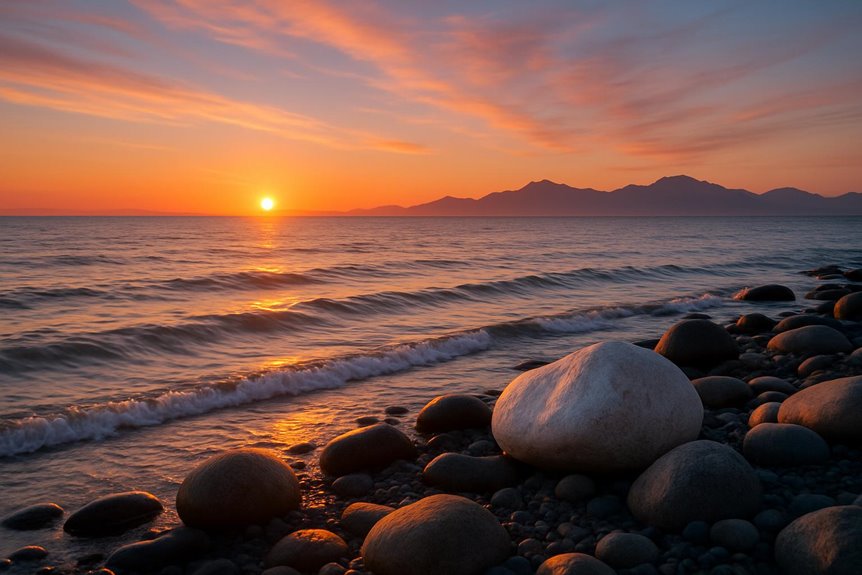White Rock’s 470-metre pier into Semiahmoo Bay offers some of the most striking lines you’ll find on the coast, especially when Mount Baker shows up in the distance on a clear day. It’s the kind of view that stops you mid-walk, whether you’re carrying a camera or not. The 2.2-kilometre promenade that stretches along the water gives you a lot to work with: driftwood and sea grass at the west end, clean horizon lines near the centre, and rocky outcrops to the east that frame portraits naturally. We usually plan around golden hour and the tide chart because that’s when the beach turns reflective and gives even simple shots a polished look.
Capturing the Iconic White Rock Pier

This isn’t just any pier—it’s a White Rock landmark. Stretching nearly half a kilometre into Semiahmoo Bay, it creates strong natural lines that work especially well for framing and composition. You’ll get more out of it by heading right to the dock at the very end. It’s quieter on weekday mornings, and the view is wide open. Mount Baker often makes an appearance in the background, and when the lighting’s soft, you’ll have everything you need to get something clean and eye-catching without too much editing after the fact.
Beach Photography Along the Promenade
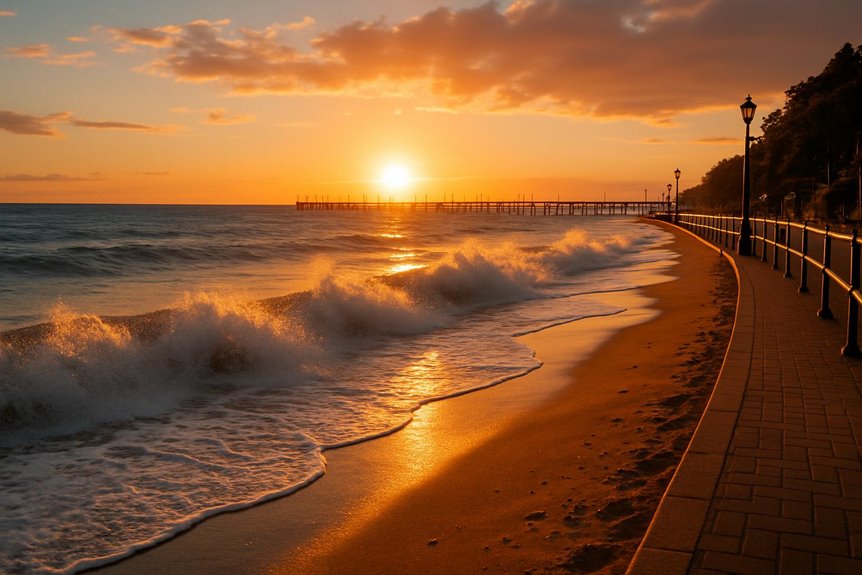
Beach Photography Along the Promenade
We’ve walked the full length of the promenade, West Beach to East Beach, more times than we can count, and the light always makes the difference. Golden hour adds depth and tone to the water, sand, and sky, but you’ll want to match that with the tide. Low tide during that late-day window gives you the best reflections and textures along the shoreline. Once you’ve figured out your timing, focus on using the walkway’s natural curves, elevated railings, and beach transitions to frame your shot with intention rather than over-relying on post-processing.
Golden Hour Lighting Tips
White Rock’s light shifts fast depending on where you stand, so it pays to think ahead. We tend to start on the eastern end of the pier for late-day shoots, especially when we’re chasing warm tones and soft backgrounds. The crowds usually build along Marine Drive, so showing up mid-week gives you a cleaner view and more control over your composition. We bring a printed tide chart; apps are handy, but we like having something visual to reference on the go. That timing between retreating tides and fading daylight always gives us the best results.
Tide Timing Strategies
Tide timing completely transforms your White Rock photography. We’ve found that knowing the promenade’s 2.2-kilometre stretch means timing when water meets pier for those perfect reflections. Here’s what works:
- Early morning or late afternoon during low tide gives you maximum beach space
- High tide creates different compositions when water reaches the pier’s end
- Golden hour timing with retreating tides leaves brilliant wet sand reflections
- Checking tide schedules stops you missing that calm pre-tide atmosphere
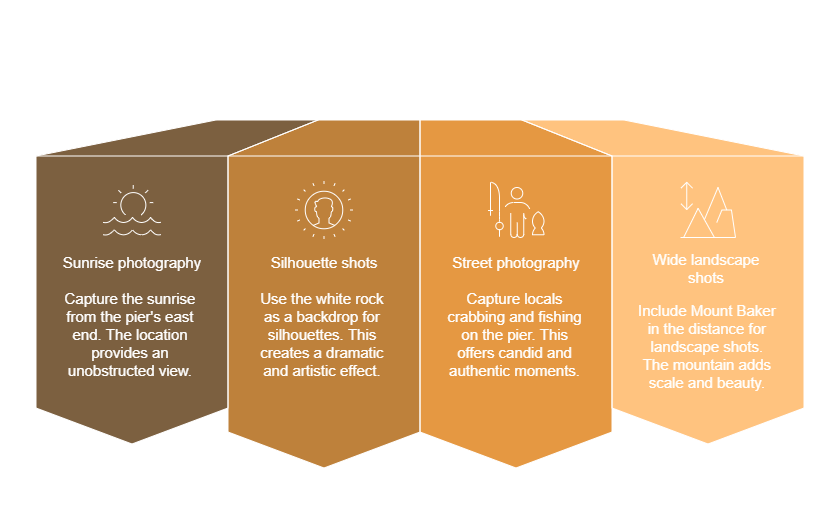
We always bring tide charts because they change everything. That White Rock pier looks completely different as water levels shift, giving you fresh angles every visit.
Composition Along Walkway
White Rock’s promenade breaks down into three distinct shooting zones, each with its own character. The western end gives you intimate elements to work with—driftwood and beach grass make natural frames that we love using. Head east and you’ll hit the sweet spot where the pier meets those endless horizon lines. Quick tip: place your subjects against the railings for leading lines that pull viewers right into your frame. The eastern section has dramatic rocky outcrops that work brilliantly for environmental portraits. With 2.2 kilometres to work with, you’re never limited to just one style of shot.
The Historic White Rock and Waterfront Views

The Historic White Rock and Waterfront Views
We stumbled upon White Rock’s waterfront and immediately knew we’d found something special. Just a short drive from Vancouver, this spot offers everything photographers need. The famous white boulder creates a beautiful contrast against the blue water, exactly what you want for those perfect shots.
The historic pier extends 460 metres into Semiahmoo Bay, giving you multiple angles to work with:
- Sunrise photography from the pier’s eastern end
- Silhouette shots using the massive white rock as backdrop
- Street photography capturing locals crabbing and fishing
- Wide landscape shots that include Mount Baker in the distance
This waterfront consistently delivers the results you’re after, whether you’re shooting for clients or building your portfolio. We return here regularly because the conditions and scenery work so well together.
Vibrant Street Art and Mural Locations
Not every shot has to be near the beach. We’ve had some of our best portrait sessions around town using White Rock’s murals as a backdrop. The 4Cats Mural on Marine Drive is a local favourite—it’s bright but balanced and works well without stealing focus from your subject. We recommend checking the city’s mural guide before heading out; it gives you a quick overview of the best spots and how to get there. Each mural has its own energy, and finding one that suits your subject can make a big difference.
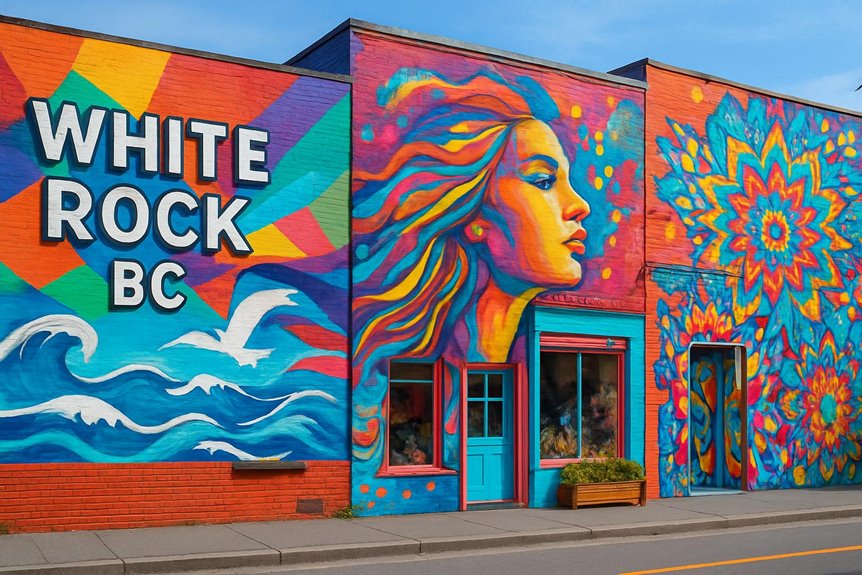
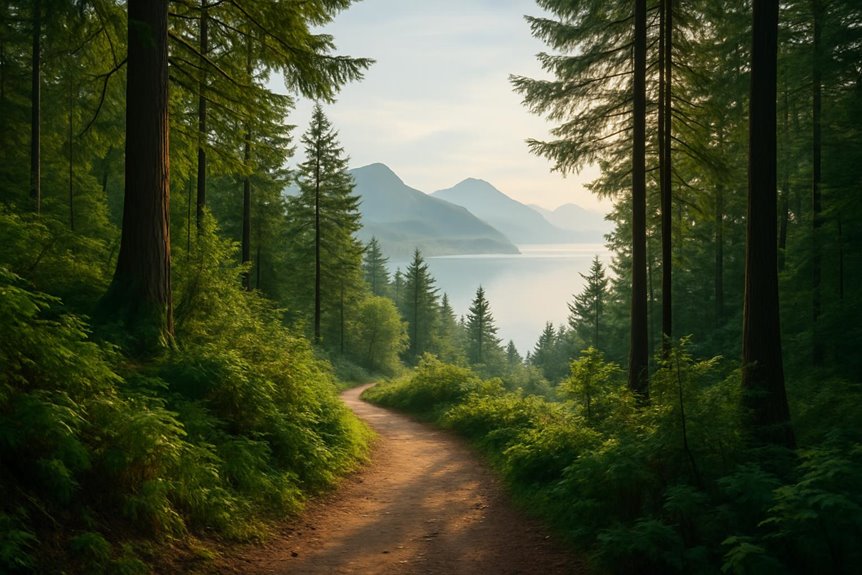
Scenic Trails and Natural Landscapes
If you’re after something quieter than the waterfront, try the trail through Duprez Ravine from Centennial Park. It’s shaded, has thick vegetation, and leads down to the beach. The changing elevation gives you room to shoot from different heights, which is especially helpful when you want to show how the land and ocean connect. There are a few hilltops nearby with wide views over the bay. It’s where we usually go when we’re after a long-exposure scene or a photo that needs more space to breathe. Wildlife and local plants show up here too, if that’s part of your project.
Golden Hour Dining With Ocean Vistas
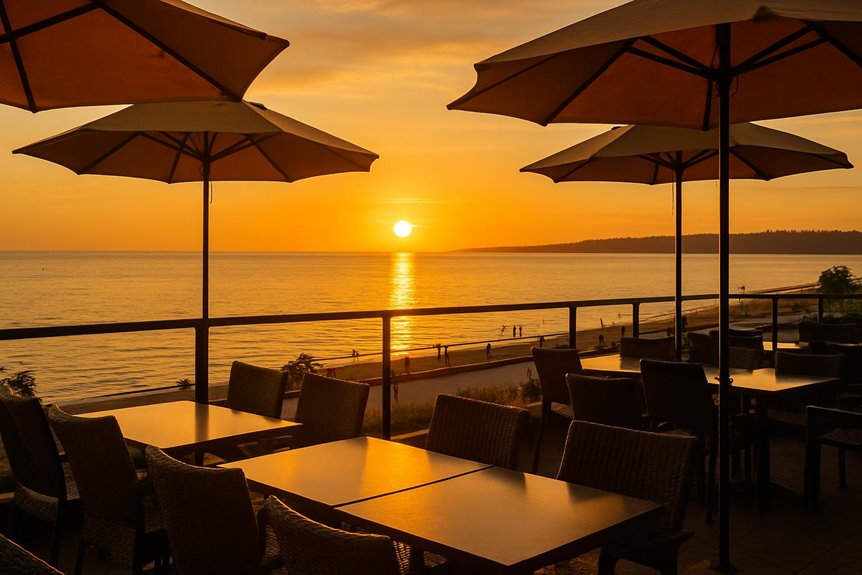
We’ve walked the full length of the promenade, West Beach to East Beach, more times than we can count, and the light always makes the difference. Golden hour adds depth and tone to the water, sand, and sky, but you’ll want to match that with the tide. Low tide during that late-day window gives you the best reflections and textures along the shoreline. Once you’ve figured out your timing, focus on using the walkway’s natural curves, elevated railings, and beach transitions to frame your shot with intention rather than over-relying on post-processing.
Questions Often Asked
What Camera Equipment Works Best for White Rock’s Changing Weather Conditions?
For White Rock’s unpredictable weather, we recommend weather-sealed DSLRs paired with fast lenses as your essential kit. The coastal conditions here change quickly, so protection matters. We always carry microfibre cloths because that ocean mist appears without warning just when you’re capturing the shot you want.
Are There Photography Permits Required for Commercial Shoots in White Rock?
Yes, photography permits are required for larger commercial shoots in White Rock, but not for smaller productions.
For most casual commercial shoots, we don’t need permits. However, when your production involves larger equipment that blocks walkways or disrupts public areas, you’ll need city approval. We always contact White Rock’s film office before starting any project—they’re genuinely helpful and want your shoot to go smoothly.
Which Months Offer the Most Dramatic Lighting for Landscape Photography?
For your most dramatic landscape shots, focus on November through February. We’ve found winter delivers the moodiest lighting – those dark December storms create incredible silver and charcoal scenes along White Rock’s coastline. These raw, emotional conditions during the colder months give you the powerful shots that stand out from casual photography.
What Are the Best Parking Options Near Popular Photo Locations?
Finding parking near popular photography spots requires local knowledge and timing.
We’ve found that Marine Drive’s metered parking disappears quickly when the light gets good. We always park on the residential roads behind the seafront instead – it’s free and gets you to your shooting spot in under two minutes on foot.
For your best results, scout alternative parking during quiet periods. Most photographers compete for obvious spaces, but side streets often offer better options. We recommend arriving 30 minutes before your planned shoot time, especially during weekends and sunset hours.
Check local parking restrictions before leaving your car. Some areas have resident-only zones or time limits that aren’t immediately obvious. We keep a parking app handy for quick payments and to find nearby alternatives when our usual spots are taken.
Your gear safety matters too. Choose well-lit streets with good visibility rather than the closest possible space. We’d rather walk an extra few minutes than worry about equipment security whilst shooting.
Are There Local Photography Workshops or Guided Tours Available?
Yes, there are local photography workshops and guided tours available.
We’ve found several local photographers who run workshops around the pier and promenade. Your best bet is to check with White Rock’s visitor centre—they regularly connect photographers with guided tours in the area. These workshops cover everything from sunset shots over the water to capturing the local wildlife and street scenes along the waterfront.

